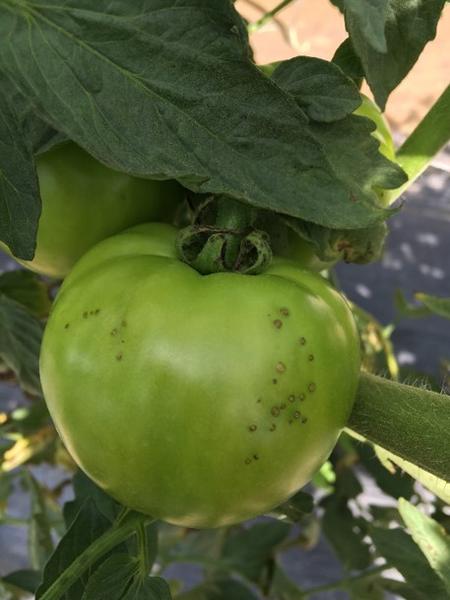Bacterial Spot of Pepper and Tomato
go.ncsu.edu/readext?588848
en Español / em Português
El inglés es el idioma de control de esta página. En la medida en que haya algún conflicto entre la traducción al inglés y la traducción, el inglés prevalece.
Al hacer clic en el enlace de traducción se activa un servicio de traducción gratuito para convertir la página al español. Al igual que con cualquier traducción por Internet, la conversión no es sensible al contexto y puede que no traduzca el texto en su significado original. NC State Extension no garantiza la exactitud del texto traducido. Por favor, tenga en cuenta que algunas aplicaciones y/o servicios pueden no funcionar como se espera cuando se traducen.
Português
Inglês é o idioma de controle desta página. Na medida que haja algum conflito entre o texto original em Inglês e a tradução, o Inglês prevalece.
Ao clicar no link de tradução, um serviço gratuito de tradução será ativado para converter a página para o Português. Como em qualquer tradução pela internet, a conversão não é sensivel ao contexto e pode não ocorrer a tradução para o significado orginal. O serviço de Extensão da Carolina do Norte (NC State Extension) não garante a exatidão do texto traduzido. Por favor, observe que algumas funções ou serviços podem não funcionar como esperado após a tradução.
English
English is the controlling language of this page. To the extent there is any conflict between the English text and the translation, English controls.
Clicking on the translation link activates a free translation service to convert the page to Spanish. As with any Internet translation, the conversion is not context-sensitive and may not translate the text to its original meaning. NC State Extension does not guarantee the accuracy of the translated text. Please note that some applications and/or services may not function as expected when translated.
Collapse ▲Inga Meadows, Amanda Scherer, and Michelle Henson | NC State University
Bacterial spot is caused by four species of Xanthomonas and occurs worldwide wherever tomatoes are grown. Bacterial spot causes leaf and fruit spots, which leads to defoliation, sun-scalded fruit, and yield loss. Due to diversity within the bacterial spot pathogens, the disease can occur at different temperatures and is a threat to tomato production worldwide. Disease development is favored by temperatures of 75 to 86 ℉ and high precipitation. In North Carolina, it is more prevalent in seasons with high precipitation and less prevalent during dry years.
The disease is caused by four species of Xanthomonas (X. euvesicatoria, X. gardneri, X. perforans, and X. vesicatoria). In North Carolina, X. perforans is the predominant species associated with bacterial spot on tomato and X. euvesicatoria is the predominant species associated with the disease on pepper. All four bacteria are strictly aerobic, gram-negative rods with a long whip-like flagellum (tail) that allows them to move in water, which allows them to invade wet plant tissue and cause infection.
For more information on Bacterial Spot including signs, symptoms and disease management, view the entire publication.

Bacterial spot symptoms on field tomatoes caused by Xanthomonas perforans. Photo Credit: Inga Meadows

Fruit lesions of bacterial spot caused by Xanthomonas perforans. Photo Credit: A. Strayer-Scherer


